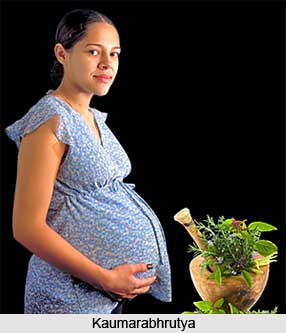 Kaumarabhrutya tantra or Bala Chikitsa is one of the eight specialized branches of Ashtang ayurveda, which deals specifically with paediatric issues. It covers all aspects of child growth from the neonatal phase to puberty including treatment for problems arising at any stage.
Kaumarabhrutya tantra or Bala Chikitsa is one of the eight specialized branches of Ashtang ayurveda, which deals specifically with paediatric issues. It covers all aspects of child growth from the neonatal phase to puberty including treatment for problems arising at any stage.
In other words, Kaumarabhrutya is the branch of Ashtang Ayurveda that deals with the diagnosis and treatment of diseases related to pregnancy, childbirth (delivery) and diseases of children (Pediatrics). With the view to achieve its ultimate aim of creating a healthy and disease free society Ayurveda attempts to care for the baby from the point of its conception upto the moment of its growth into a fully developed human being. Vagbhata, well-known for his great critical works on ancestral ayurveda samhitas, wrote two books called Ashtanga Hrudaya (heart of the eight-organed body of ayurveda) and Vagbhata Sanhita.
Vagbhata dedicated his entire life in compiling these books which serve as a great help in the everyday practice of Ayurveda. In these books or granthas, Vagbhata assembled all the appropriate information about the Ayurvedic procedure by revising ancestral sanhitas namely Charaka Sanhita, Sushruta Samhita and Sharangdhar Sanhita, and recorded them in a chronological order. Kaumarabhrutya finds mention in these books along with other branches of Ashtang Ayurveda.
Kaumarabhrutya has identified that the wellbeing of the child is directly dependant upon the mental and physical condition of the mother. It meticulously advocates proper diet, regimen, nourishment and conduct for women during and after delivery. Ayurveda also holds that mother`s milk is the best nutrition for a baby. It is absolutely essential for growth of the baby and the strengthening of its resistance system. So it is vital for the mother to attain perfect health so that she can nourish her kid. Kaumarabhrutya even deems it fit for a child to be fed by another lactating mother in case its own mother is ill or cannot produce enough milk.
Kaumarabhrutya was such an advanced branch even thousands of years ago that it made it possible to track down the growth and progress of the foetus in an accurate manner. There is also the mention of punsanvan vidhi, a technique for having a child of one`s desired sex, intellect and constitution. This branch scrupulously dealt with the problem of sterility and the associated causes and treatment procedures. Apart from all these kaumarabhrutya deals with a range of disorders that mainly affect children such as gastrointestinal diseases, teething disorder, and rickets .The treatment of these child disorders fall under the branch of Pediatrics.
Ashtanga Ayurveda believed in doctrines like `a healthy baby is tomorrow`s society` and `neonatal care in time saves future medi-care for a lifetime`. In order to achieve its eventual goal of building a healthy society, ayurvedic scholars elaborately described safety measures to be taken at every juncture of life, from conception to adolescence and thus we have this branch called Kaumarabhrutya tantra. This specialized branch aims at the welfare of the society and starts it with the wellbeing of the family, the mother, and more specifically, the child.
This specialized branch recognized direct links between the physical and mental health of an expecting mother and that of her progeny. It addressed the need for society to remain healthy by giving detailed instructions for care to be taken by a couple planning a family.




















